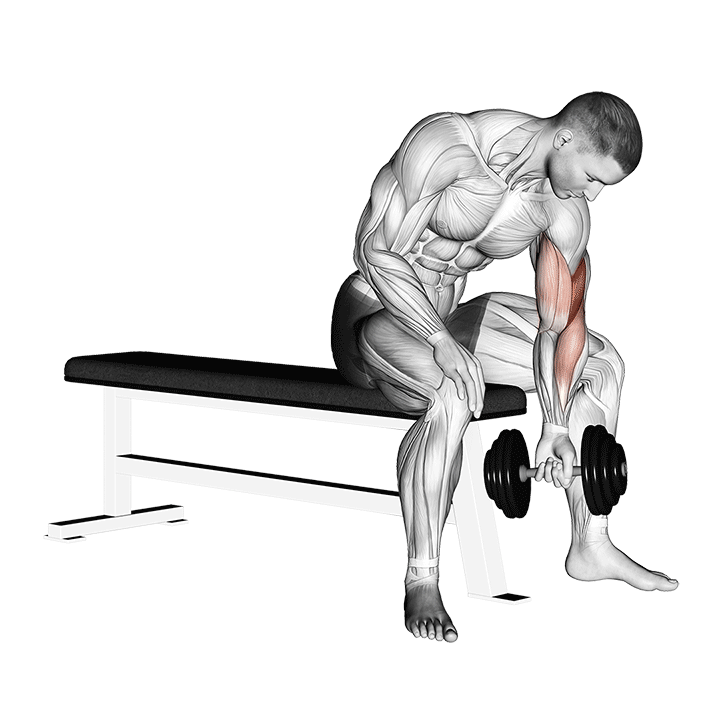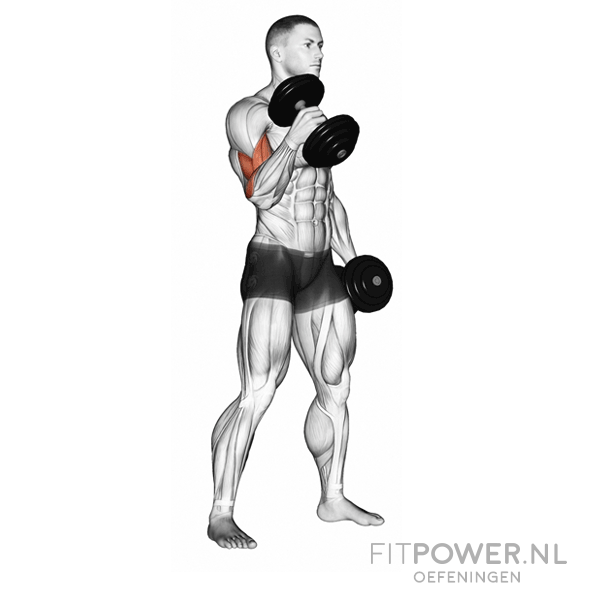An average dumbbell curls for a 14-year-old varies from person to person. Everyone is different which means some 14 years old will be able to lift heavier dumbbells due to their size, different metabolism rates, calorie intake, weight, being active(sporty) and many more factors. Furthermore, it also varies on the type of biceps workouts. People tend to go heavy on some exercises like hammer curls but when it comes to concentrated curls it gets harder. Therefore, you have to drop your dumbbell weight significant and make sure you’re performing the exercise in the correct manner. So, …
What are the Average Dumbbell curls for a 14-year-old?
Answer: An average 14-year-old should curl from 7.72 – 26.4 Lbs (3.5-12kg) dumbbell. It’s recommended starting form smaller dumbbell(10 lbs) and work your way up until you’re comfortable with the weight. One step at a time. In this way, you’re very less likely to injure yourself. There is a lot of momentum involved when performing Dumbbell curls. You probably see this in the gym where people be swinging their arms and not having much focus on their biceps.
- Check: – Average Height to bodyweight
- Must read: – Average Bench press for 14-year-old
- Must read: – Average Deadlift for 14-year-old
- Must read: – Average Squats for 14-year-old
How to reduce Injuries when performing Dumbbell curls?

Injuries are very likely to occur when performing dumbbell curls. Some of the reasons for injuries are bad for/techniques, Heavyweights, overtraining and warmups. The injury could occur on your chest, shoulders, and arms.
- Bad Form/Techniques: You need to make sure that you focus on the correct muscle group when performing Dumbbell curls. You will see a lot of people performing the same exercise, but their form is slightly different to others. This is due to bad Form/Techniques. When performing dumbbell curls, you need to remove momentum and keep each rep nice and controlled. This means No swinging, curling up with the medium pace and slowly bringing it back to the starting position. This will result in no pressure or discomfort on your Lower back and traps.
- Heavy Weights: Lots of people in the gym like to compete “He curls 15 Kgs for 10 reps, I can do that too” This leads to injuries on your forearms and wrist. You will see people in the gym lifting heavy weights even though they are in pain and discomfort. This will also lead to bad form. Therefore, curls whatever weight is medium/heavy for you. For example, if you can easily do 10 kg dumbbell curls for 12 reps then move to 12 kg dumbbell curls and not jump to 18 kg. Remember, training is a long-term investment so you need to make sure that you can lift it without getting injured.
- Overtraining: Training too often can cause injuries to your muscle group and joints as you need to allow your muscle to repair. Give yourself some recovery time if you have discomfort, continued pain, or illness on your forearms. Take a few days off; Rest. Put some ice on your forearms as it will reduce the swelling and the pain. If the pain is still there, then seek advice from health professionals.
- Warmups: Warmups are important as they will help prevent any pulling muscles/injuries. There are some warm exercises you can perform before doing bench presses as it will let your chest muscle get ready for heavier sets. Personally, for my warmups, I like to do lightweight with lots of reps (empty bar and 25 reps).
How to improve my dumbbell curls?

This depends on what your goals are. You want to Increase Strengthen Biceps, Gaining Biceps Muscle Size, and Toning Biceps. All these goals will have a slightly different impact on Biceps.
- Strengthen Biceps: This is where you challenge the strength of your forearms and biceps. By performing heavy dumbbells and performing two – six sets of biceps workouts. With a heavyweight aim for 8 -10 reps at the same time try to keep your form as correct as possible. Due to heavy weight, you need to make sure you have enough rest time between each set. Rest time should be anywhere between 2 mins to 4 mins between each set. Additionally, try not to perform the same strength training for the consecutive day. Give your muscle some rest to recover.
- Gaining Muscle Size: Increase your biceps muscle. This is how Bodybuilders train. The aim for this is to have large and well-defined muscles (biceps). Get a dumbbell where the weight is medium/heavy and perform two – six sets of biceps workouts. Always ensure your form is correct when performing dumbbell curls. Make sure your rep range for each set is from 10-12 reps. Rest time should be anywhere from 30 – 120 seconds between each set. Make sure you perform Gaining Muscle Size training for the biceps once a week.
- Toning Biceps: There is a high number of women who choose this type of workout as it tones down the muscle without increasing its size. Use a weight which is light and perform two-four sets of biceps workouts. With the correct form perform 15 -20 reps as you will be focusing on muscle endurance. The more reps the more resistance. As the weight is lighter, your rest time should be shorter, anywhere from 15 – 30 seconds. You can perform this type of bicep training 2 times a week.
All these types of training will help you increase your biceps. However, that is not enough. You need to make sure you have enough rest to allow the muscle to grow. Having a good diet is important as it will increase the process.
Dumbbell curls exercises for Bigger Biceps
1) Concentrated Dumbbell Curls
Primary Muscle Target: Biceps Brachii
Secondary Muscle Target: Brachialis
Benefits of Concentrated Dumbbell Curls
- There is more tension on your bicep compared to standard bicep curls.
- The strength of the bicep muscle increases with bicep hypertrophy.
- Improve your performance on other exercises.
- Increase your athletic performance within any sport which requires the use of arms.
- You will be able to get bigger arms, more toned up and more defined biceps depending on your goals.
How to perform Concentrated Dumbbell curls?

STEP 1 – Sit down on a flat bench with your legs wider than your hip and grab the dumbbell.
STEP 2 – Lean your upper body towards your legs to a point where you should at a 45-degree angle.
STEP 3 – Place your elbow on your inner thighs above your knees and to add more stability place another hand on the same leg. Make sure your arms are in the straight position and the dumbbell is above the floor.
STEP 4 – Curl your biceps.
STEP 5 – Squeezing your biceps on every rep (on the top and returning position).
STEP 6 – Do 10-12 reps and switch your arms after.
2) Zottman Dumbbell Curls

Primary Muscle Target: Biceps Brachii
Secondary Muscle Target: Brachialis & Brachioradialis
Benefits of Zottman Dumbbell Curls
- Great exercise for building bicep and forearm muscles.
- The forearm activation is increased when performing Zottman curls.
- The grip strength will increase over time after performing Zottman curls.
- The positive portion hits the biceps and the Negative portion hits the forearms which makes it more Time-efficient.
- This exercise will lead to bigger and better-looking arms over time.
How to perform Zottman Dumbbell curls?

STEP 1 – Stand straight, knees slightly bent for balance. Hold the dumbbells so the palms face your legs. Makes sure your torso is straight and your abs are tensed.
STEP 2 – Curls the weight towards your shoulders but make sure your upper arms are closer to your sides and your elbows are bent. Make sure when curling your biceps are fully contracted.
STEP 3 – Get into a pronated grip where you rotate your forearms so your palms are now facing downwards without lowering the weight down.
STEP 4 – While in the pronated position lower the weight down to the starting position.
STEP 5 – Repeat the STEPS for 10-12 reps.
3) Preacher Dumbbell Curls

Primary Muscle Target: Biceps Brachii
Secondary Muscle Target: Brachialis & Brachioradialis
Benefits of Preacher Dumbbell Curls
- Great exercise for building the bicep.
- There is no swinging weight due to no momentum created to curl the weight upwards as this exercise for the user to control the weight.
- Preacher curls add more load on the biceps and forearms as your biceps works in isolation.
- This exercise focuses on the negative movement. Negative movement is the lengthening of muscles under load. This can be observed in the eccentric phase of an exercise.
How to perform Preacher Dumbbell curls?

STEP 1 – Grab a medium-weight dumbbell for yourself to curl.
STEP 2 – The aim is to have your forearm in front of you, so find a surface to rest your elbows and back part of your arms.
STEP 3 – Curls and raise the dumbbell towards your face while keeping your wrist stable and in line with your arms and elbows.
STEP 4 – The aim is to only move your elbow down and keep the back of your arms fixed.
STEP 5 – Control the weight and slowly lower the dumbbell back to starting position.
STEP 6 – Repeat the STEPS for 10-12 reps.
4) Hammer Dumbbell Curls

Primary Muscle Target: Biceps Brachii
Secondary Muscle Target: Brachialis, Brachioradialis, back and chest
Benefits of Hammer Dumbbell Curls
- Great exercise for bicep size and strength
- Hammer Curls will help increase the wrist stability
- Boosts muscle endurance
- The grip strength will increase over time after performing
How to perform Preacher Dumbbell curls?

STEP 1 – Stand up straight and grab the dumbbell making sure your palms are facing your body. Keep your feet hip-width apart and engage your core to stabilize the body.
STEP 2 – Make sure your biceps are stationary. Lift the dumbbell by bending your elbows.
STEP 3 – Reach your shoulder level with the dumbbell but make sure not to touch your shoulders.
STEP 4 – Make sure to contract when reached to the top and slowly go back down to the starting position.
STEP 5 – Repeat the STEPS for 10-12 reps.
TrainRightMuscle Are Affiliates!
Just so you know, we receive a share of sales or other compensation from the products links on this page. Thank you for using our links.



